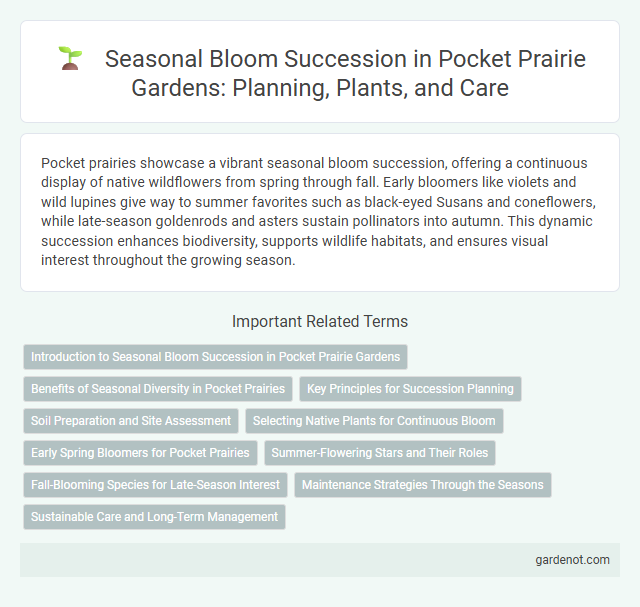Pocket prairies showcase a vibrant seasonal bloom succession, offering a continuous display of native wildflowers from spring through fall. Early bloomers like violets and wild lupines give way to summer favorites such as black-eyed Susans and coneflowers, while late-season goldenrods and asters sustain pollinators into autumn. This dynamic succession enhances biodiversity, supports wildlife habitats, and ensures visual interest throughout the growing season.
Introduction to Seasonal Bloom Succession in Pocket Prairie Gardens
Seasonal bloom succession in pocket prairie gardens ensures continuous floral display by strategically planting native wildflowers and grasses that flower at different times throughout the year. This technique enhances biodiversity and supports pollinators such as bees, butterflies, and hummingbirds by providing a consistent nectar source from early spring to late fall. Proper planning of bloom succession also optimizes garden aesthetics while maintaining ecological balance in small-scale prairie ecosystems.
Benefits of Seasonal Diversity in Pocket Prairies
Seasonal bloom succession in pocket prairies supports continuous habitat and food sources for pollinators, enhancing biodiversity throughout the year. Diverse plant species with staggered blooming periods improve soil health by promoting nutrient cycling and preventing erosion. This seasonal diversity also contributes to ecosystem resilience, enabling pocket prairies to adapt to climatic variations and sustain wildlife populations effectively.
Key Principles for Succession Planning
Seasonal bloom succession in pocket prairies maximizes biodiversity by strategically selecting native plant species that flower at different times throughout the growing season, ensuring continuous pollinator support. Key principles for succession planning involve understanding plant phenology, maintaining species diversity, and managing spatial distribution to create overlapping bloom periods. This approach enhances ecosystem resilience and sustains essential habitat functions year-round.
Soil Preparation and Site Assessment
Effective soil preparation for pocket prairies involves thorough site assessment including soil texture, pH levels, and nutrient content to ensure optimal plant growth. Incorporating organic matter improves soil structure and moisture retention, promoting a healthy environment for a diverse succession of native wildflowers and grasses. Proper site evaluation allows selection of species that bloom sequentially, extending the seasonal floral display and supporting pollinator activity throughout the growing season.
Selecting Native Plants for Continuous Bloom
Selecting native plants for a pocket prairie ensures a continuous bloom succession that supports local pollinators and ecosystem health. Early bloomers like wild columbine and Virginia bluebells provide critical nectar sources in spring, while summer species such as coneflowers and bee balm extend flowering periods. Late bloomers like goldenrod and asters sustain pollinators into fall, creating a balanced, year-round habitat.
Early Spring Bloomers for Pocket Prairies
Early spring bloomers in pocket prairies, such as bloodroot (Sanguinaria canadensis), trout lily (Erythronium americanum), and spring beauty (Claytonia virginica), provide crucial nectar and pollen sources for emerging pollinators. These native perennials thrive in well-drained soil conditions and initiate growth as temperatures rise, ensuring a continuous food supply during the seasonal bloom succession. Incorporating early spring species supports biodiversity and establishes a foundation for the complex floral progression throughout the growing season.
Summer-Flowering Stars and Their Roles
Summer-flowering stars such as purple coneflower, black-eyed Susan, and bee balm drive the seasonal bloom succession in pocket prairies by providing continuous nectar sources and habitat for pollinators during peak summer months. These native perennials enhance biodiversity by supporting butterflies, bees, and hummingbirds, promoting ecosystem resilience. Their staggered blooming periods ensure a prolonged flowering season, crucial for sustaining pollinator populations and maintaining ecological balance.
Fall-Blooming Species for Late-Season Interest
Fall-blooming species like asters, goldenrods, and ironweed extend flowering periods in pocket prairies, providing vital nectar sources for pollinators late in the season. These plants support biodiversity by sustaining insects such as bees, butterflies, and moths when many summer blooms have faded. Incorporating late-season bloomers enhances aesthetic appeal and ecological function during autumn, ensuring continuous habitat and food supply.
Maintenance Strategies Through the Seasons
Seasonal bloom succession in pocket prairies relies on targeted maintenance strategies such as timed mowing, selective weeding, and adaptive watering schedules to support diverse native plant species throughout the year. Early spring maintenance includes cutting back dead stems to promote new growth, while summer focuses on controlling invasive species and ensuring adequate hydration during dry spells. Fall practices involve leaving seed heads intact for natural reseeding and performing light pruning to prepare the prairie for dormancy and robust spring emergence.
Sustainable Care and Long-Term Management
Seasonal bloom succession in pocket prairies enhances ecological balance by supporting diverse pollinators throughout the year. Sustainable care involves minimal mowing, native species selection, and controlled invasive removal to promote resilience and soil health. Long-term management prioritizes adaptive strategies that respond to climate variations and habitat shifts, ensuring persistent biodiversity and ecosystem services.
Seasonal bloom succession Infographic

 gardenot.com
gardenot.com